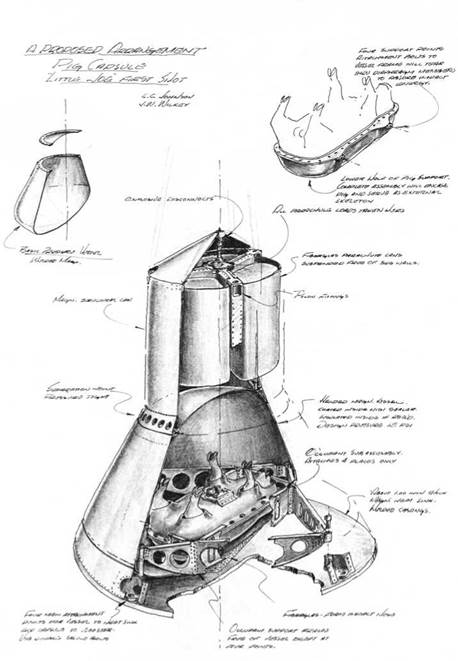OF PIGS AND ASTRONAUT COUCHES
“Those were the days of the most intensive and dedicated work of a group of people that I have ever experienced,” Gilruth once wrote in a conference paper. “None of us will ever forget it. We were making tests of escape rockets over on the beach at Wallops
Island, testing parachutes in full-scale drops from helicopters, and measuring water impact loads on capsule configurations at Langley Field.”14
Meanwhile, impact studies were also being carried out at the McDonnell plant, with test capsules dropped into water, onto sand beds, and onto solid concrete slabs. In one series of tests, live pigs were loaded into a Mercury capsule, strapped into a specially built contour couch similar to those being individually developed for the astronauts. The capsule was then dropped down a long shaft blunt end first to verify that a human passenger could survive a particularly hard landing, as described in the official NASA Project Mercury history.
“Through April and May (1959), McDonnell engineers fitted a series of four Yorkshire pigs into contour couches for impact landing tests of the crushable aluminum honeycomb energy-absorption system. These supine swine sustained acceleration peaks from 38 to 58 g before minor internal injuries were noted. The ‘pig drop’ tests were quite impressive, both to McDonnell employees who left their desks and lathes to watch them and to STG engineers who studied the documentary movies. But, still more significant, seeing the pigs get up and walk away from their forced fall and stunning impact vastly increased the confidence of the newly chosen astronauts that they could do the same. The McDonnell report on these experiments concluded, ‘Since neither the acceleration rates nor shock pulse amplitudes applied to the specimens resulted in permanent or disabling damage, the honeycomb energy absorption system of these experiments is considered suitable for controlling the landing shock applied to the Mercury capsule pilot.’”15
Jerry Roberts was a Guidance and Control System Engineer working at the Cape with McDonnell, and he still remembers conducting those drop tests using live animals.
“When we were designing the spacecraft we knew nothing about the effects of weightlessness on the astronaut – on the human body. We also knew very little about what would actually happen during the launch and recovery process. We knew it would be pretty rugged, so one of the things we had to do was design a seat for the astronauts to give them the maximum protection possible in this confined space. And believe me it was confined; the men could just barely fit into the Mercury spacecraft.
“The small MAC group that I was with came up with a couch for the astronauts to sit in, molded around the astronauts’ bodies. It was constructed out of a honeycomb material. We did this individually for each astronaut.” The couches, backed by an energy-absorbing, crushable aluminum honeycomb, consisted of a fiberglass shell with protective rubber padding, and were located in the pressurized section of the capsule.
“Then we needed to test it to see how much protection it actually provided, and since most of the astronauts weighed about 160-180 pounds, someone came up with the idea of using pigs that were in that weight range.
“We had a test facility constructed inside one of our lab buildings and it was fixed so that we could take these hogs up to varying heights. They were sedated of course, and we dropped them down a chute into a bed of wet, packed sand. We recorded the Gs that each one was subjected to, but I know we started out at about eight feet and then went [up] in four foot intervals. I think the last pig was dropped at 20 feet, or

|
maybe even higher. As it turned out the seat did provide significant protection and so the test was successful.
“Immediately after each pig was subjected to the drop test the animal was butchered; the local butcher did all the slaughtering right there in the facility and the pig’s internal organs were examined in great detail to see what damage resulted from the fall. The meat was frozen and I think was later donated to [some charity] the equivalent of a soup kitchen. It was not thrown out or wasted.”16










